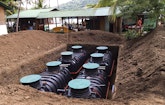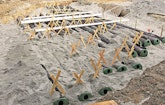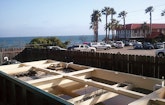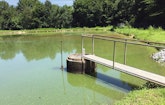System allows lighthouse to be converted into a bed-and-breakfast
Problem: When the lighthouse keeper’s house on Cuckolds Island in Maine was in use, it had an overboard discharge. Faced with demolition, a local group fought to save the lighthouse. During the renovation, it was decided to make the residence a bed-and-breakfast. There needed to be a way to treat and dispose of about 500 gpd of wastewater. The initial plan was to pump the wastewater through a 1.5-mile pipe on the ocean bed and up the shore to the mainland, where it would go under a pond and road to a septic field. This plan was opposed by both the Army Corps of Engineers and the state.
Solution: Albert Frick of Albert Frick and Associates designed a system meeting the state’s criteria using a BUSSE GT500 system coupled with a SoilAir disposal field that fit within the limited area of a small lawn next to the lighthouse. This was possible because the system produces an effluent that has less than 5 mg/L of TSS and BOD as well as less than 1 fecal coliform bacterium per liter, so little or no breakdown of the wastewater takes place in the disposal field. The effluent then naturally flows through rocks, sand and soils into the ocean. Because the system is seasonal, fall shutdown and spring startup can be accomplished without the need to remove any sludge from the property.
Result: The system meets or exceeds all required standards. It makes the property useable as a bed-and-breakfast. 708-204-3504; www.busse-gt.com.
Compact system recommended for tight fire station property
Problem: Skylonda Fire Station in Woodside, California, needed a septic system to accommodate a new fire station. The site had significant constraints including reserve areas; space for a required redundant system; setbacks; and large, protected redwood trees. Many technologies were prohibitive due to space constraints and were too costly.
Solution: San Mateo County approved the Advanced Enviro-Septic treatment and dispersal technology from Presby Environmental for a 1,620 gpd, 540-linear-foot primary system with a 600-linear-foot redundant system to be installed under pavement. The primary system has gravity flow to the septic tank and to the pump chamber, then volume lift dose to the Advanced Enviro-Septic system.
Result: The system allowed for construction of the new fire station and has performed as advertised. 800-473-5298; www.presbyeco.com.
System allows homeowner to list home for sale
Problem: A six-bedroom home in Snyder County, Pennsylvania, needed a replacement septic system. The older, existing cesspool failed and had to be repaired in order to sell the home. The site had multiple constraints, including 20 inches to a limiting factor, a poor perc rate, and setback constraints from a township diversion ditch, property line, neighbor’s well, and creek. A new system required over 1,700 square feet to meet regulations. An elevated sand mound would not fit on the site, and there were limited options for the usable available space.
Solution: Jim Sanders’ design included 80 B43 geotextile sand filter modules from Eljen in a nontraditional bed configuration to meet sizing and square-footage requirements. The low-pressurized system was shaped to meet unique site features by using six rows of differing lengths, keeping laterals on contour and stepping laterals down the slope. Timed dosing was also used to spread out the total gpd over a 24-hour period. The system, along with the new septic and dose tanks, was installed by Cliff Crider and Matt Good, and the units and onsite training were provided by Expert Septic.
Result: The homeowner now has a code-compliant system and is able to list it for sale. The system had lower material costs than an elevated sand mound, treats the effluent to NSF Standard 40 and meets Pennsylvania’s treatment standards. The system has minimal maintenance requirements, and no future media replacement is necessary. 800-444-1359; www.eljen.com.
UV used to disinfect Malibu, California, restaurant effluent
Problem: Located on the oceanfront in Malibu, California, Duke’s Malibu is a popular restaurant, dedicated to Duke Kahanamoku, the father of surfing. Wastewater from the restaurant averages 6,000 gpd, and it must be treated on site and directly discharged to the sensitive beach environment. The existing treatment system was outdated and was causing numerous water quality and discharge violations.
Solution: Carlile Macy was selected to provide an upgraded treatment system. They chose an upflow sludge blanket filtration system, or USBF, and SALCOR UV disinfection system, consisting of four 3G UV units in two parallel tracks. The California Regional Water Quality Control Board and city of Malibu approved their design.
Result: The new treatment system produced high-quality effluent, which has met the stringent disinfection requirement of California Title 22. Results have been consistent over five years of operation. Effluent total coliform count has been nondetectable, and the dissolved oxygen concentration has averaged 6 mg/L. The high-quality discharge has reduced coliform levels in the groundwater from more than 1,600 MPN to less than 2 MPN. Because of wastewater fat, oil and grease content, the UV units were initially inspected weekly for possible fouling of the Teflon barrier. Those inspections were suspended during the first year of operation because no fouling had occurred. 760-731-0745.
Advanced treatment system goes undercover on Costa Rican island
Problem: Isla Chiquita is a luxury island camping resort in Costa Rica that is only accessible by small boat. To gain approval, owners needed a high-yield advanced wastewater treatment system that would meet stringent environmental codes that preserve the protected island. The system had to be prefabricated, transported to the island by small boat, installed with no concrete, invisible to guests once installed, and removable at the end of a limited-time concession. Treated effluent of less than 30 mg/L FOG and 150 mg/L COD was required with no noticeable septic odors, and the system couldn’t exceed 38 dB for environmental noise.
Solution: Bionest Costa Rica designed a modular wastewater treatment system with a design flow of 2,378 gpd to serve 15 tents, a restaurant and other resort facilities. The design features two modular Bionest 1,189 gpd fixed-media bioreactor systems installed in parallel. All wastewater from the facilities is conveyed by PVC pipes to four IM-1060 settling tanks from Infiltrator Water Technologies. Solids and liquid separation and anaerobic biological treatment of the effluent is completed in the tanks. Following the settling tanks, the effluent travels to bioreactors inside four additional IM-1060 tanks equipped with Bionest media, fine-bubble diffusers, and a recirculation system for tertiary treatment. The treated water then travels through a disinfection unit before use in the resort’s underground drip irrigation system.
Result: The resort opened in spring 2017, and the wastewater treatment system is functioning well with no visual, noise or odor issues to distract resort guests. 800-221-4436; www.infiltratorwater.com.
System used to treat lagoon wastewater
Problem: A small community in Tennessee was utilizing a lagoon system to treat domestic wastewater. The state issued the community a more stringent permit for discharge of the wastewater into a nearby tributary. The primary concern was the lower ammonia limit established in the new permit.
Solution: The project contractor selected Delta Environmental’s ECOPOD-N to further treat all of the wastewater constituents down to the new permit requirement. The design utilizes a two-staged ECOPOD-N FBBR treatment system, consisting of two engineered ECOPOD-N models. Incoming flow to the treatment system is 5,000 gpd with an average ammonia concentration of 45 mg/L. The system is designed to facilitate the nitrification process by providing required aeration and using a fixed-bed biological reactor to promote bacterial growth for biological ammonia reduction. The second-stage unit provides further BOD/TSS reduction to ensure effluent meets the discharge standard. The external controls also incorporated variable-frequency drives for ease of adjustment to the air supply in the event that ammonia levels or environmental factors fluctuate. The effluent gravity flows through a chlorine disinfection system, followed by dechlorination treatment, before final release into the tributary.
Result: The project contractor was able to quickly and easily install the new treatment system. The site has successfully maintained discharge permit requirements. 800-219-9183; www.deltaenvironmental.com.











